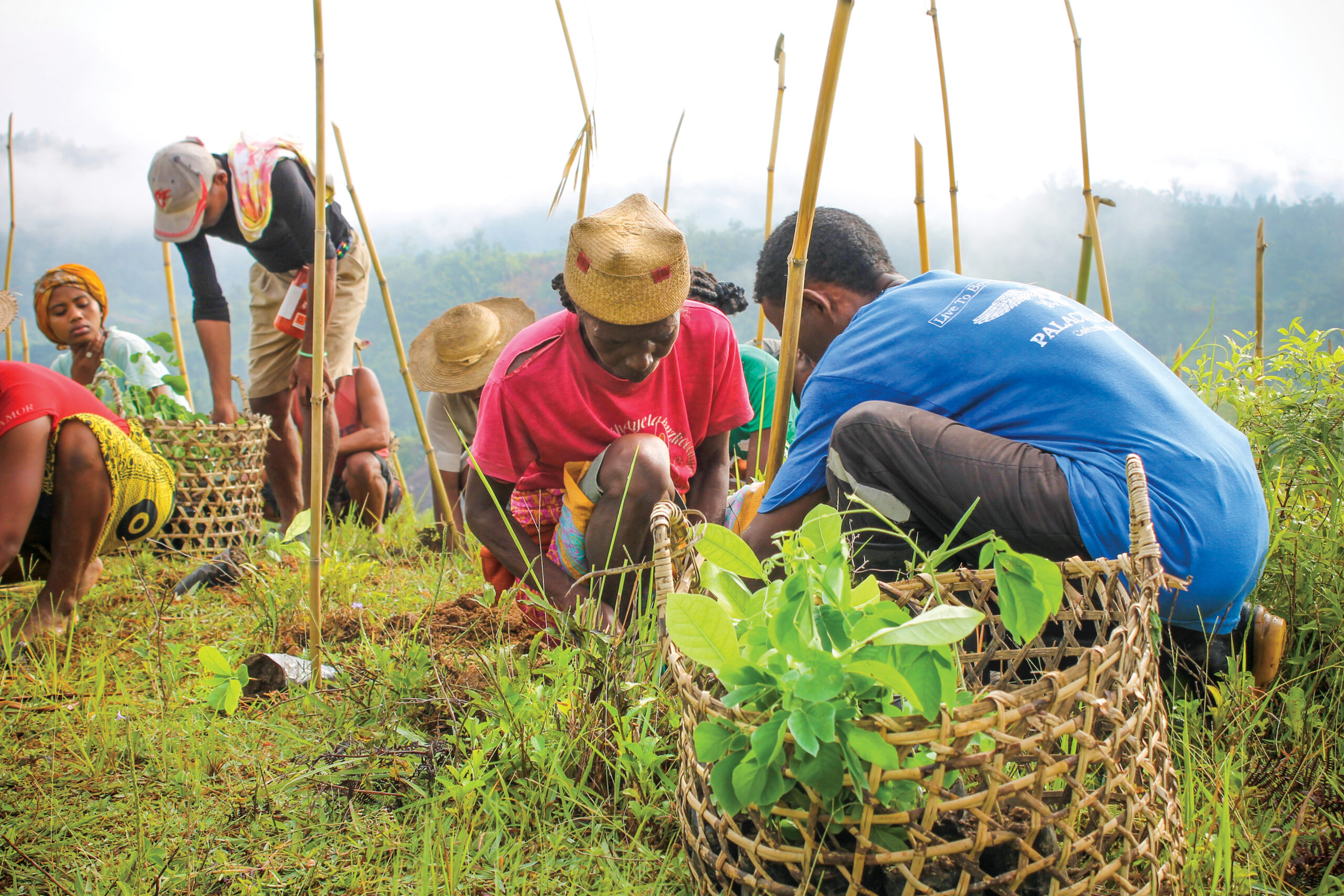How JGI teamed up with HP and the Arbor Day Foundation to plant a million native trees in the past year to restore vital ecosystems.
In a world filled with environmental challenges, it’s important to highlight positive developments that bring hope and promise through action. In just one year, the Jane Goodall Institute (JGI), HP, and the Arbor Day Foundation have planted one million native trees in forests of great need around the world! The collaboration not only inspires us to take steps towards a more sustainable future, it’s making real progress to improve vulnerable wildlife habitat. Find out how our work together is making a difference.
This remarkable collaboration aimed to plant one million trees and by allocating a portion of sales from HP products in North America over a six-week period to support native and community-led tree plantings. JGI joined the project through our 🔗Jane’s Green Hope campaign, an initiative to catalyze action to protect forests.
Dr. Jane Goodall herself kicked off the campaign by 🔗“forest bathing” with actress, producer and writer Rebel Wilson — a symbol of their shared commitment to forest regeneration. This unique approach brought attention to the importance of protecting lifegiving forests through community-led efforts, fostering hope and connection.
When it came time to plant, these trees found their homes in six sites across the United States, Madagascar, and Brazil strategically chosen to make an impact ecologically and in the lives of local communities.
What makes this partnership truly special is its focus on local communities. Local people have played a leading role every step of the way—from cultivating seedlings in regional nurseries, to planting them, to managing the forests over time.
Project planning followed a strict protocol to help ensure success. Only regionally native species were selected, and local forest management teams were assigned to help benefit the surrounding communities.
The focus on not just planting trees, but ensuring their survival and positive impact is a testament to the dedication of the people involved. It’s about restoring ecosystems and supporting sustainable communities. Let’s delve into the six sites where these efforts are making a difference.
Econfina + Chipola River, Florida
After Hurricane Michael devastated Florida’s Econfina Creek and Chipola River watersheds, the project focused on restoring native pine species. Important for restoring the health of these watersheds, the plantings will provide critical habitat for numerous wildlife species, including the threatened gopher tortoise and bobwhite quail.

Archie Creek Fire, Oregon
In Oregon, the Archie Creek Fire wreaked havoc, threatening key habitats for threatened species. The replanting of native species, such as Douglas fir and red cedar, will both provide terrestrial habitat for the northern spotted owl as well as enhance streamside habitats for threatened Coho salmon.

Lemur Habitat, Madagascar
The Madagascar Biodiversity Partnership is working tirelessly to rebuild the lush landscape of Madagascar, home to critically endangered lemurs. The tree planting efforts are both reviving the rainforest and also improving the lives of the local people. Over 5,000 community members have participated in the project, many of whom earn income from cultivating and planting seedlings.




Amazon Rainforest, Northwest Brazil
In northwest Brazil, our effort worked to restore Indigenous lands across three states in the vast Amazon Rainforest: Rondônia, Mato Grosso, and Acre. The goal is to provide food security and sustainable income alternatives for thousands of indigenous people. Working in this biodiverse landscape is critical to continue mitigating climate change and support sustainable livelihoods for local communities.

Monongahela National Forest, West Virginia
Restoring red spruce stands on reclaimed mining lands in the Monongahela National Forest is essential for many endemic and migratory species of wildlife. In addition to helping this degraded landscape recover, these efforts help ensure the survival of animals like the Cheat Mountain salamander, northern flying squirrel, and golden-winged warbler.




State Lands, Washington
In Washington, unsustainable and outdated forestry practices like clearcutting, combined with disease and insect infestations, have taken their toll. Replanting efforts in Washington state are focused on providing habitat for the endangered northern spotted owl and restoring fragmented forests and wetlands on which countless species depend.
The partnership between JGI, HP, and the Arbor Day Foundation demonstrates the power of collaboration in achieving meaningful conservation goals. By leveraging corporate resources and emphasizing genuine investments in sustainability, this work not only makes a positive impact on the environment, but also on the lives of local communities. After all, the well-being of people relies on the health of our ecosystems.
HP’s commitment to forest protection is encouraging, and their involvement in this campaign showcases their dedication to environmental stewardship. The tree planting initiative also aligns with 1t.org, a project of the World Economic Forum to grow, restore and conserve one trillion trees. The initiative emphasizes the potential of nature-based solutions to improve well-being, combat climate change, and protect biodiversity.
At a time when climate action is more urgent than ever, this partnership gives us hope.
“We are running out of time… if we plant trees, and if we help to restore forests, and if we help to protect forests that already exist with all their rich biodiversity, we can save Mother Earth.”
Dr. Jane Goodall, DBE, Founder of the Jane Goodall Institute and UN Messenger of Peace
So, let’s take inspiration from the Plant a Tree with HP campaign. Join our #JanesGreenHope initiative—tell us on social media how you #PlantHope in your own community! It’s through collective action and partnerships like these that we can make a real difference and ensure a healthy planet for all.

